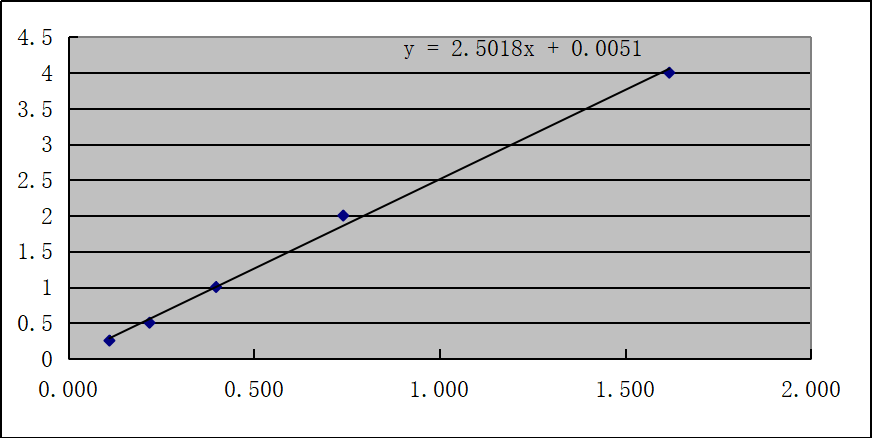| Usage |
Specimen Requirements
1. Specimens should be extracted as soon as possible after collection, following the relevant literature. Experiments should be performed as soon as possible after extraction. If experiments cannot be performed immediately, specimens may be stored at -20°C, but repeated freezing should be avoided.
2. Samples containing sodium nitrate (NaN3) cannot be assayed, as NaN3 inhibits horseradish peroxidase (HRP) activity.
Procedure
1. Dilution of Standard: This kit provides one standard sample at full strength. Users can dilute the sample in a small test tube according to the following chart.
4μg/L |
Standard No. 5 |
150μl of original standard was added to 150μl of standard diluent |
2μg/L |
Standard No. 4 |
150μl of standard No. 5 was added to 150μl of standard diluent |
Standard No. 3 |
Add 150μl of Standard No. 4 to 150μl of Standard Diluent |
0.5μg/L |
Standard No. 2 |
Add 150μl of Standard No. 3 to 150μl of Standard Diluent |
0.25μg/L |
|
Calculation
Draw a standard curve on graph paper with the concentration of the standard as the horizontal axis and the OD value as the vertical axis. Find the corresponding concentration of the sample from the standard curve based on the OD value of the sample; then multiply it by the dilution factor; or use the concentration of the standard and the OD value to calculate the linear regression equation of the standard curve, substitute the OD value of the sample into the equation to calculate the sample concentration, and then multiply it by the dilution factor to obtain the actual concentration of the sample.

Standard Curve
| Sensitivity |
0.05 μg/L |
| Species Reactivity |
Chinese hamster |
| Synonym |
Chinese hamster PLBL2/PLBD2 ELISA Kit |
| Detection Type |
Used to determine the content of phospholipase B-like 2 (PLBL2) in hamster serum, plasma and related fluid samples. |
| Composition |
Serial number |
Component name |
Specification |
Serial number |
Component name |
Specification |
1 |
30 times concentrated detergent |
20ml×1 bottle |
6 |
Developer B solution |
6ml×1/bottle |
2 |
Enzyme Labeled Reagent |
6ml×1 bottle |
7 |
Stop Solution |
6ml×1 bottle |
3 |
Enzyme-coated plate |
12 wells ×8 strips |
8 |
Standard (8 μg/L) |
0.5 ml ×1 bottle |
4 |
Sample diluent |
6 ml ×1 bottle |
9 |
Standard diluent |
1.5ml×1 bottle |
5 |
Developer A Liquid |
6ml×1 bottle |
10 |
Sealing film |
2 photos |
|
| General Notes |
1. After removing the kit from the refrigerator, allow it to equilibrate at room temperature for 1 hour before use. If the enzyme-coated plate is opened and not completely used, store it in a sealed bag. 2. Crystals may form in the concentrated wash buffer. Warming in a water bath during dilution can aid dissolution. This will not affect the results during washing. 3. Use a pipette for each sample addition step and frequently calibrate its accuracy to avoid experimental error. The time for each addition should ideally be within 5 minutes. For large numbers of samples, using a dispenser is recommended. 4. Execute a standard curve with each measurement, preferably in duplicate. If the analyte content in the sample is too high (the sample OD value is greater than the OD value of the first standard well), dilute the sample a certain number of times (n times) with sample diluent before measurement. When calculating the final dilution, multiply by the total dilution factor (×n×5). 5. The sealing film is for single use only to avoid cross contamination.
6. Please store the substrate in a dark place.
7. Strictly follow the instructions for operation. The test results must be determined based on the readings of the microplate reader.
8. All samples, washing solutions and various wastes should be treated as infectious materials.
9. Components of different batches of this reagent must not be mixed.
|
| Storage Temp. |
Unopened test kit, stored at 2-8°C, has a shelf life of 6 months. |
| Test Range |
0.15μg/L-5μg/L |
|



